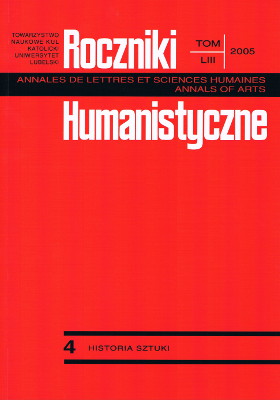The Lublin Castle in the 16th Century and in the First Half of the 17th Century
Abstract
The present buildings on the castle hill were erected mostly at the beginning of the 19th century. The 13th century donjon and the Trinity Chapel the building of which is associated with Casimirus the Great belong to the oldest ones, connected with the functions of the castellan’s town. The castle, built by Casimirus, and developed as a Renaissance residence in the times of Sigismund the Old and modernized in the subsequent centuries, has very few iconographie records. We can get some idea of what it looked like in the Piast times on the basis o f the preserved foundations that have only partially been excavated. We can make guesses about the distribution of buildings on the castle hill also basing on the mural that has recently been discovered on a wall in the Lubomelskis’ house in the Lublin Market Square. The Renaissance silhouette of the castle is shown in the co lo red copperplate from the 6th book of “Civitates orbis terrarum ” published in Cologne in 1618. More detailed information about the arrangement of the castle buildings, their connections and functions, and partly also about their furnishing comes from written sources. The main one is the inventory of the Lublin starosty including also the inventory of the castle from 1618. The successive changes of the function and relatively small re constructions are described in the records of two inspections of the starosty of 1602 and 1616. Owing to these sources it is possible to learn about the look of the castle in the period of its splendor. From analysis of these sources it appears that foreigners and other visitors were impressed not only with the position of the castle but also with its buildings and furnishing. Since the wars of the middle of the 17th century completely destroyed the castle our image of its splendor is formed only on the basis of the sources.
References
Adamek T., Renesansowa architektura Lublina, w: Lublin w dziejach i kulturze Polski, Lublin 1997.
Bartkiewicz M., Odzież i wnętrza domów mieszkalnych w Polsce w drugiej połowie XVI i XVII wieku, Wrocław 1974.
Gawarecki H., Kultura artystyczna miasta w okresie renesansu, w: Dzieje Lublina. Próba syntezy, t. 1, Lublin 1965.
Gawarecki H., Najstarszy widok Lublina A. Hogenberga z 1617 roku i jego późniejsze powtórzenie w XVII i XVIII wieku, „Studia i Materiały Lubelskie” Historia sztuki, t. 1(1963).
Gąsiorowski A., Intinerarium króla Władysława Jagiełły 1386-1434, Warszawa 1971.
Gąsiorowski A., Intineraria dwu ostatnich Jagiellonów, „Studia Historyczne”, t. XVI(1973), z. 2.
Gradowski M., Żygulski Z. jun., Słownik uzbrojenia historycznego, Warszawa 1998.
Gwagnin A., Z Kroniki Sarmacyi Europejskiej, Kraków 1860.
Kurzątkowski M., Zamek Lubelski i początki renesansu na Lubelszczyźnie, „Studia i Materiały Lubelskie”, t. 7(1967).
Kwaśniewicz W., 1000 słów o dawnej broni palnej, Warszawa 1987.
Najdawniejszy widok Lublina wyjęty z dzieła Jerzego Brauna p.n.„Theatrum praecipuarum totus mundi urbium” z 1618 roku wydał w dokładnej podobiźnie z objaśnieniami Hieronim Łopaciński, Warszawa 1901.
Neuman M., Intinerarium Aleksandra Jagiellończyka wielkiego księstwa litewskiego, króla polskiego, „Zeszyty Naukowe Uniwersytetu Adama Mickiewicza w Poznaniu”, Historia nr 11, Poznań 1971.
Niemcewicz J. U., Podróże historyczne po ziemiach polskich między rokiem 1811 a 1828 odbyte, Paryż 1858.
Rolska-Boruch I., Malarski portret gotyckiego miasta Lublina w kamienicy Lubomelskich, w: Ikonografia dawnego Lublina, Lublin 1999.
Rozwałka A., Lubelskie wzgórze staromiejskie w procesie formowania średniowiecznego miasta, Lublin 1997.
Szczygieł R., Śladkowski W., Zarys dziejów miasta, Lublin 1993.
Urzędnicy województwa lubelskiego XVI-XVII w., Spisy, oprac. W. Kłaczewski i W. Urban pod red. A. Gąsiorowskiego, Kórnik 1991.
Walicki M., Malowidła ścienne kościoła św. Trójcy na Zamku w Lublinie (1418), Warszawa 1930.
Wojciechowski S., Renesansowy zamek lubelski, „Ochrona Zabytków”, R.7:1954, nr 3.
Copyright (c) 2005 Roczniki Humanistyczne

This work is licensed under a Creative Commons Attribution-NonCommercial-NoDerivatives 4.0 International License.





